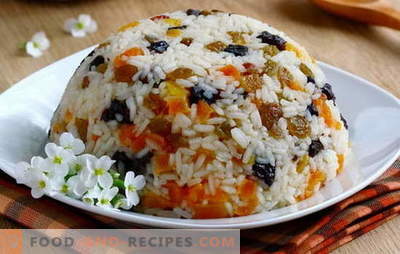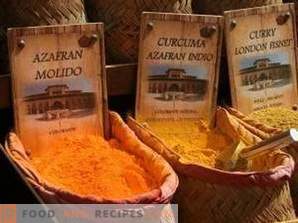
Pilaf is always made from meat with rice, but for some reason it has so many flavors! Of course, the result depends largely on the added spices. In Asian countries, this is what they pay special attention to. That pilaf does not smell like rice or carrots. It has a special aroma and taste that can not be forgotten. What would add to the cauldron?
Classic spices for pilaf
Of course, you can just go and buy a bag in the supermarket that says “Seasoning for pilaf”. By default, it should fit perfectly into the dish. But it does not happen. First, the pilaf is cooked with different meats. It is not good to fill a chicken with one spice and use it for lamb. Secondly, the bags are often not at all what is indicated. Sometimes use overdried seasonings, dust from herbs, not fresh seeds. If you collect all the seasonings separately and mix, the aroma will be much brighter, like the taste.
Classic proportions per 1 kg of rice:
- 1 tsp. sweet paprika;
- 5 barberry berries;
- 1 tsp. pepper mixes;
- 0.5 tsp. zira;
- 0.5 tsp. saffron;
- 1 head of garlic (5-8 cloves).
Often saffron is replaced by turmeric. By the way, these are different spices, do not confuse them. Also, lovers of spirits sometimes add it much more, it's a matter of personal taste. In the Uzbek pilaf there is additionally savory and coriander. All these seasonings are introduced into the cauldron during the preparation of pilaf. If you want to mix spices for future use, then only dry ingredients are used. Wet products should not be added, they quickly deteriorate.
An interesting fact. A large amount of spices and hot peppers began to be added to pilaf, not for taste, but as preservatives. It was very difficult to save the dish in hot oriental countries without a refrigerator, so the locals tried to do it this way.
Spices for pilaf with different meats
What meat does classic pilaf cook with? There is no answer to this question, it all depends on the country, religion, culinary preferences. Therefore, the spices used are different for each type. If earlier classics was considered to be pilaf with lamb and fat-rich fat, now options with poultry, beef, and even pork are very popular. Why not highlight their tastes? What can be added:
- Pilaf with chicken. In addition to the cumin and saffron, you can add a little ground thyme, a pinch of basil and sliced hot chili peppers. Sometimes they stick a whole fresh or dried pod.
- Lamb Pilaf. In addition to the classic set of spices, rosemary and basil will perfectly fit into it. You can use fresh twigs or dry greens.
- Pork pilaf. You can do with a standard mixture of spices, but sumac, rosemary, mint leaf will help to enhance the taste of this meat. It is customary to add laurel to this meat.
- Lamb Pilaf. You can get by with a standard set of spices, but fenugreek will be useful in this swim, you can add a little thyme and, certainly, dogwood or barberry.
- Pilaf with turkey. Gentle dietary meat can not supplement a large number of spices. Such a float has enough saffron, turmeric, you can just pour curry seasoning.
Dried fruits in the pilaf? Can!
Many know about eastern pilaf with dried fruits, some people even practice. Indeed, raisins, dried apricots, prunes fit perfectly into the dish, emphasize the taste of red meat, give new notes. Sometimes dried quince and even pears are added.
What you need to know:
- No need to add a lot of dried fruits. On a pilaf cauldron there is enough 100-150 grams or one big handful.
- Before using dried fruits you need to rinse thoroughly.
- Dried apricots and prunes are usually chopped, but they can also be used whole.
- There is no need to add dried fruits to the zirvak, they will simply become slack. Such ingredients are introduced into the cauldron together with rice.
You can also find variations of oriental pilaf with nuts, seeds, and sesame. They have a right to exist, but during cooking these ingredients often change their taste. Therefore, it is better to add them to the finished dish, you can pre-fry in a dry frying pan.
By the way, in addition to dried fruit, pomegranate grains are added to Armenian pilaf. But in no case in the Kazan. They sprinkle the dish already on the table. It turns out very beautiful, bright and unusual.
How to add spices correctly
- Dry seasonings are usually introduced into zirvac. When heated, they reveal the taste, soak the meat.
- Seeds, for example, cumin, can be separately fried slightly in a dry frying pan, or you can do this together with onions in oil before adding other ingredients.
- Salt is added to cream, but not at the beginning. Let the meat come to softness, then it can be seasoned.
- Garlic is injected with a whole head, removing the top dirty husk. Dental clean and disassemble is not necessary. You can add a little dry or chopped garlic to the zirvak, it won't exactly spoil the pilaf.
- If the spices do not seem very fragrant, then it is recommended to grind them in a mortar with a pinch of salt, only after that add to the cauldron.
What can not be added to the pilaf
Pilaf loves spices and seasonings, but not all kinds. Some products can just spoil it. But for some reason they continue to add to the dish, and then grieve the result.
Why not add to plov:
- Dried dill, cilantro. When cooked, this green changes the taste, spoils the rice, interrupts the aroma of the meat. It is more reasonable to sprinkle fresh pilaf with fresh greens or to offer herbs separately on a platter.
- Bulgarian pepper. Dry paprika — yes, fresh, frozen, canned peppers — no. Vegetable types of pilaf fall under the exception, but it’s better not to call them this word, it’s just rice with vegetables.
- Tomato paste. How many housewives add it! Tomatoes in the pilaf is not the place Bright color and rich aroma are achieved by roasting meat, carrots, keeping saffron, and turmeric.
Careful it is worth being with a bay leaf.
No need to grind it and add to the total mass. In most pilau recipes, you can do without laurel. If you want, then throw on top of 1-2 leaves. In no case do not deepen, do not torment in zirvake. Otherwise, the pilaf will have an unpleasant bitterness, an unusual aftertaste. If you follow the rules, then add laurel only in pilaf with pork.























